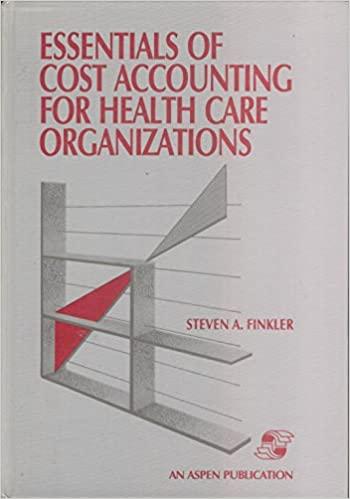Question
5 . Jammer Company uses a weighted average perpetual inventory system and reports the following: What is the per unit value of ending inventory on
5. Jammer Company uses a weighted average perpetual inventory system and reports the following: What is the per unit value of ending inventory on August 31? Answers should be rounded to the nearest cent.
| Date | Activities | Units Acquired at Cost | Units Sold at Retail |
|---|---|---|---|
| August 2 | Purchase | 10 units @ $31 = $310 | |
| August 18 | Purchase | 15 units @ $34 = $510 | |
| August 29 | Sales | 20 units sold | |
| August 31 | Purchase | 14 units @ $35 = $490 |
6. Childers Company, which uses a perpetual inventory system, has an established petty cash fund in the amount of $500. The fund was last reimbursed on November 30. At the end of December, the fund contained the following petty cash receipts: If, in addition to these receipts, the petty cash fund contains $234.75 of cash, the journal entry to reimburse the fund on December 31 will include:
| December 4 | Merchandise purchased | $ 59 |
|---|---|---|
| December 7 | Delivery expense | $ 83 |
| December 12 | Purchase of office supplies | $ 48 |
| December 18 | Miscellaneous expense | $ 67 |
16. Salmone Company reported the following purchases and sales of its only product. Salmone uses a perpetual inventory system. Determine the cost assigned to the ending inventory using FIFO.
| Date | Activities | Units Acquired at Cost | Units Sold at Retail |
|---|---|---|---|
| May 1 | Beginning inventory | 176 units @ $10 = $1,760 | |
| May 5 | Purchase | 246 units @ $12 = $2,952 | |
| May 10 | Sales | 166 units @ $20 | |
| May 15 | Purchase | 126 units @ $13 = $1,638 | |
| May 24 | Sales | 116 units @ $21 |
18. Salmone Company reported the following purchases and sales of its only product. Salmone uses a perpetual inventory system. Determine the cost assigned to ending inventory using LIFO.
| Date | Activities | Units Acquired at Cost | Units Sold at Retail |
|---|---|---|---|
| May 1 | Beginning inventory | 186 units @ $10 = $1,860 | |
| May 5 | Purchase | 256 units @ $12 = $3,072 | |
| May 10 | Sales | 176 units @ $20 | |
| May 15 | Purchase | 136 units @ $13 = $1,768 | |
| May 24 | Sales | 126 units @ $21 |
19. Salmone Company reported the following purchases and sales for its only product. Salmone uses a perpetual inventory system. Determine the cost assigned to cost of goods sold using LIFO.
| Date | Activities | Units Acquired at Cost | Units Sold at Retail |
|---|---|---|---|
| May 1 | Beginning inventory | 184 units @ $10 = $ 1,840 | |
| May 5 | Purchase | 254 units @ $12 = $ 3,048 | |
| May 10 | Sales | 174 units @ $20 | |
| May 15 | Purchase | 134 units @ $13 = $ 1,742 | |
| May 24 | Sales | 124 units @ $21 |
21. A company's inventory records report the following: Using the FIFO perpetual inventory method, what is the value of the inventory at August 15 after the sale?
| Date | Activities | Units Acquired at Cost | Units Sold at Retail |
|---|---|---|---|
| August 1 | Beginning inventory | 15 units @ $36 = $540 | |
| August 5 | Purchase | 10 units @ $37 = $370 | |
| August 12 | Purchase | 20 units @ $38 = $760 | |
| August 15 | Sales | 30 units sold |
22. Salmone Company reported the following purchases and sales of its only product. Salmone uses a periodic inventory system. Determine the cost assigned to the ending inventory using FIFO.
| Date | Activities | Units Acquired at Cost | Units Sold at Retail |
|---|---|---|---|
| May 1 | Beginning inventory | 176 units @ $10 = $1,760 | |
| May 5 | Purchase | 246 units @ $12 = $2,952 | |
| May 10 | Sales | 166 units @ $20 | |
| May 15 | Purchase | 126 units @ $13 = $1,638 | |
| May 24 | Sales | 116 units @ $21 |
23. Salmone Company reported the following purchases and sales of its only product. Salmone uses a periodic inventory system. Determine the cost assigned to cost of goods sold using FIFO.
| Date | Activities | Units Acquired at Cost | Units Sold at Retail |
|---|---|---|---|
| May 1 | Beginning inventory | 150 units @ $10 = $1,500 | |
| May 5 | Purchase | 220 units @ $12 = $2,640 | |
| May 10 | Sales | 140 units @ $20 | |
| May 15 | Purchase | 100 units @ $13 = $1,300 | |
| May 24 | Sales | 90 units @ $21 |
29. A company purchases merchandise for $21,500. The seller also offers credit terms of 2/10, n/30. Assuming no returns were made, and that payment was made within the discount period, what is the net cost of the merchandise?
Step by Step Solution
There are 3 Steps involved in it
Step: 1

Get Instant Access to Expert-Tailored Solutions
See step-by-step solutions with expert insights and AI powered tools for academic success
Step: 2

Step: 3

Ace Your Homework with AI
Get the answers you need in no time with our AI-driven, step-by-step assistance
Get Started


